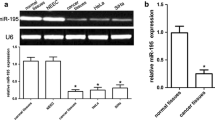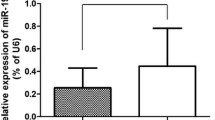Abstract
MicroRNAs (miRNAs) are important regulators of many physiological and pathological processes, including cell proliferation, apoptosis, and cell cycle arrest. In this study, we aimed to investigate the biological role of miR-155 in cervical cancer and the underlying molecular mechanism involved in tumorigenesis. The expression of miR-155 in human cervical cancer tissues was detected by real-time PCR. MTT assay and BrdU incorporation assay were used to measure the proliferation of cervical cancer cells. Apoptosis cells and cell cycle distribution were analyzed by flow cytometry. We found that the expression of miR-155 was upregulated in cervical cancer tissues compared to the adjacent non-cancer tissues. Overexpression of miR-155 promoted the proliferation of Hela and SiHa cells. By contrast, downregulation of miR-155 inhibited the growth of cervical cancer cells. Flow cytometry analysis showed that low expression of miR-155 promoted apoptosis and induced cell cycle arrest in Hela and SiHa cells. Moreover, the mRNA and protein expression of LKB1 was significantly reduced in cervical cancer tissues. Luciferase reporter assay demonstrated that LKB1 was a target gene of miR-155, suggesting that miRNA-155 promoted the proliferation of cervical cancer cells by regulating LKB1 expression.




Similar content being viewed by others
References
Jemal A, Bray F, Center MM, Ferlay J, Ward E, Forman D. Global cancer statistics. CA Cancer J Clin. 2011;61:69–90.
Ferlay J, Shin HR, Bray F, Forman D, Mathers C, Parkin DM. Estimates of worldwide burden of cancer in 2008: GLOBOCAN 2008. Int J Cancer. 2010;127:2893–917.
Wang X, Tang S, Le SY, Lu R, Rader JS, Meyers C, et al. Aberrant expression of oncogenic and tumor-suppressive microRNAs in cervical cancer is required for cancer cell growth. PLoS One. 2008;3:e2557.
Li Y, Wang F, Xu J, Ye F, Shen Y, Zhou J, et al. Progressive miRNA expression profiles in cervical carcinogenesis and identification of HPV-related target genes for miR-29. J Pathol. 2011;224:484–95.
Colombo N, Carinelli S, Colombo A, Marini C, Rollo D, Sessa C. Cervical cancer: esmo clinical practice guidelines for diagnosis, treatment and follow-up. Ann Oncol. 2012;23 Suppl 7:i27–32.
Hwang HW, Mendell JT. MicroRNAs in cell proliferation, cell death, and tumorigenesis. Br J Cancer. 2007;96(Suppl):R40–4.
Tamura M, Uyama M, Sugiyama Y, Sato M. Canonical Wnt signaling activates miR-34 expression during osteoblastic differentiation. Mol Med Rep. 2013;8:1807–11.
Vasudevan S, Tong Y, Steitz JA. Switching from repression to activation: microRNAs can up-regulate translation. Science. 2007;318:1931–4.
Bandres E, Agirre X, Bitarte N, Ramirez N, Zarate R, Roman-Gomez J, et al. Epigenetic regulation of microRNA expression in colorectal cancer. Int J Cancer. 2009;125:2737–43.
Marcucci G, Maharry KS, Metzeler KH, Volinia S, Wu YZ, Mrozek K, et al. Clinical role of microRNAs in cytogenetically normal acute myeloid leukemia: miR-155 upregulation independently identifies high-risk patients. J Clin Oncol. 2013;31:2086–93.
Yang M, Shen H, Qiu C, Ni Y, Wang L, Dong W, et al. High expression of mir-21 and mir-155 predicts recurrence and unfavourable survival in non-small cell lung cancer. Eur J Cancer. 2013;49:604–15.
Jiang S, Zhang HW, Lu MH, He XH, Li Y, Gu H, et al. MicroRNA-155 functions as an OncomiR in breast cancer by targeting the suppressor of cytokine signaling 1 gene. Cancer Res. 2010;70:3119–27.
Pedersen IM, Otero D, Kao E, Miletic AV, Hother C, Ralfkiaer E, et al. Onco-mir-155 targets SHIP1 to promote TNFalpha-dependent growth of B cell lymphomas. EMBO Mol Med. 2009;1:288–95.
Costinean S, Sandhu SK, Pedersen IM, Tili E, Trotta R, Perrotti D, et al. Src homology 2 domain-containing inositol-5-phosphatase and CCAAT enhancer-binding protein beta are targeted by miR-155 in B cells of Emicro-MiR-155 transgenic mice. Blood. 2009;114:1374–82.
Gocze K, Gombos K, Juhasz K, Kovacs K, Kajtar B, Benczik M, et al. Unique microRNA expression profiles in cervical cancer. Anticancer Res. 2013;33:2561–7.
Gironella M, Seux M, Xie MJ, Cano C, Tomasini R, Gommeaux J, et al. Tumor protein 53-induced nuclear protein 1 expression is repressed by miR-155, and its restoration inhibits pancreatic tumor development. Proc Natl Acad Sci U S A. 2007;104:16170–5.
Huang X, Taeb S, Jahangiri S, Emmenegger U, Tran E, Bruce J, et al. MiRNA-95 mediates radioresistance in tumors by targeting the sphingolipid phosphatase SGPP1. Cancer Res. 2013;73:6972–86.
Li T, Kon N, Jiang L, Tan M, Ludwig T, Zhao Y, et al. Tumor suppression in the absence of p53-mediated cell-cycle arrest, apoptosis, and senescence. Cell. 2012;149:1269–83.
Glienke W, Maute L, Wicht J, Bergmann L. The dual PI3k/mTOR inhibitor NVP-BGT226 induces cell cycle arrest and regulates survivin gene expression in human pancreatic cancer cell lines. Tumour Biol. 2012;33:757–65.
Higgs G, Slack F. The multiple roles of microRNA-155 in oncogenesis. J Clin Bioinforma. 2013;3:17.
Wingo SN, Gallardo TD, Akbay EA, Liang MC, Contreras CM, Boren T, et al. Somatic LKB1 mutations promote cervical cancer progression. PLoS One. 2009;4:e5137.
Ji H, Ramsey MR, Hayes DN, Fan C, McNamara K, Kozlowski P, et al. LKB1 modulates lung cancer differentiation and metastasis. Nature. 2007;448:807–10.
Shah U, Sharpless NE, Hayes DN. LKB1 and lung cancer: more than the usual suspects. Cancer Res. 2008;68:3562–5.
Martin SG, St JD. A role for drosophila LKB1 in anterior-posterior axis formation and epithelial polarity. Nature. 2003;421:379–84.
Shackelford DB, Shaw RJ. The LKB1-ampk pathway: metabolism and growth control in tumour suppression. Nat Rev Cancer. 2009;9:563–75.
Green AS, Chapuis N, Lacombe C, Mayeux P, Bouscary D, Tamburini J. LKB1/AMPK/mTOR signaling pathway in hematological malignancies: from metabolism to cancer cell biology. Cell Cycle. 2011;10:2115–20.
Zhang X, Chen H, Wang X, Zhao W, Chen JJ. Expression and transcriptional profiling of the LKB1 tumor suppressor in cervical cancer cells. Gynecol Oncol. 2014.
Acknowledgments
This study was supported by Key Construction Project of Changning District Health Bureau, Shanghai.: Changning District Minimally Invasive Gynecologic Surgery Center (Project Number 2004105001)
Conflicts of interest
None
Author information
Authors and Affiliations
Corresponding author
Rights and permissions
About this article
Cite this article
Lao, G., Liu, P., Wu, Q. et al. Mir-155 promotes cervical cancer cell proliferation through suppression of its target gene LKB1. Tumor Biol. 35, 11933–11938 (2014). https://doi.org/10.1007/s13277-014-2479-7
Received:
Accepted:
Published:
Issue Date:
DOI: https://doi.org/10.1007/s13277-014-2479-7




